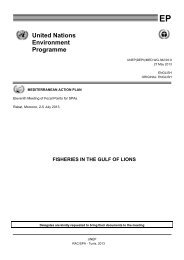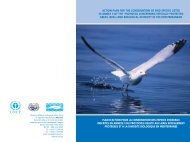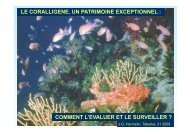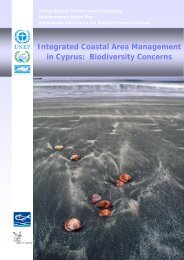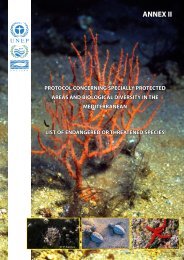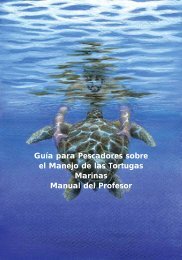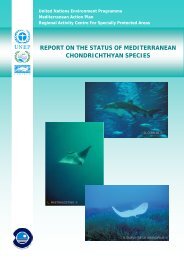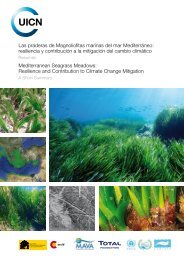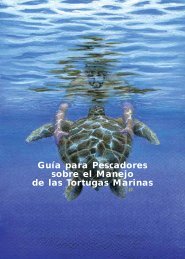Proceedings of the Second Mediterranean Symposium on Marine
Proceedings of the Second Mediterranean Symposium on Marine
Proceedings of the Second Mediterranean Symposium on Marine
You also want an ePaper? Increase the reach of your titles
YUMPU automatically turns print PDFs into web optimized ePapers that Google loves.
Tab 1: Percentage values <str<strong>on</strong>g>of</str<strong>on</strong>g> chorological elements for each divisi<strong>on</strong><br />
Rhodophyta Phaeophyta Chlorophyta<br />
Lig. Lig. Lig. Lig. Lig. Lig.<br />
2003 1950 2003 1950 2003 1950<br />
number <str<strong>on</strong>g>of</str<strong>on</strong>g> entities 151 177 44 54 48 43<br />
Cosmopolitans (C+SC) 27,8 23,9 42,2 35,3 27,1 37,5<br />
Wide distributi<strong>on</strong> (A+AP+IA+IP) 23,2 22,7 17,8 17,6 27,1 27,5<br />
Cold affinities (Ab+APtf+IAtf+CB+CBA) 19,2 26,4 11,1 19,6 10,4 5,0<br />
Warm affinities (P+Abt+APt+At+IAt) 17,9 14,1 11,1 7,8 31,3 22,5<br />
<str<strong>on</strong>g>Mediterranean</str<strong>on</strong>g> 11,9 12,9 17,8 19,6 4,2 7,5<br />
DISCUSSION AND CONCLUSION<br />
An inversi<strong>on</strong> <str<strong>on</strong>g>of</str<strong>on</strong>g> <str<strong>on</strong>g>the</str<strong>on</strong>g> trend is observed in <str<strong>on</strong>g>the</str<strong>on</strong>g> chorological spectra. In fact, in <str<strong>on</strong>g>the</str<strong>on</strong>g> historical<br />
data, cold affinity elements are more important than <str<strong>on</strong>g>the</str<strong>on</strong>g> warm <strong>on</strong>es, while <str<strong>on</strong>g>the</str<strong>on</strong>g> actual list<br />
shows an opposite trend (Fig. 2), except for Chlorophyta, where both warm and coldaffinity<br />
elements increase (Tab. 1).<br />
The present work seems to c<strong>on</strong>firm <str<strong>on</strong>g>the</str<strong>on</strong>g> popular <str<strong>on</strong>g>the</str<strong>on</strong>g>ory <str<strong>on</strong>g>of</str<strong>on</strong>g> <str<strong>on</strong>g>Mediterranean</str<strong>on</strong>g> Sea warming,<br />
at least for Liguria, typically <strong>on</strong>e <str<strong>on</strong>g>of</str<strong>on</strong>g> <str<strong>on</strong>g>the</str<strong>on</strong>g> colder regi<strong>on</strong>s in <str<strong>on</strong>g>the</str<strong>on</strong>g> basin. Unluckily, this bulk <str<strong>on</strong>g>of</str<strong>on</strong>g><br />
data, is very far to be exhaustive, both for what c<strong>on</strong>cerns <str<strong>on</strong>g>the</str<strong>on</strong>g> research <str<strong>on</strong>g>of</str<strong>on</strong>g> taxa to be<br />
included in <str<strong>on</strong>g>the</str<strong>on</strong>g> actual list, and for <str<strong>on</strong>g>the</str<strong>on</strong>g> tax<strong>on</strong>omical problems within <str<strong>on</strong>g>the</str<strong>on</strong>g> historical data.<br />
More time and energies will be necessary to achieve a representative list <str<strong>on</strong>g>of</str<strong>on</strong>g> Ligurian<br />
macrophytobenthos, in order to make a more accurate comparis<strong>on</strong> with <str<strong>on</strong>g>the</str<strong>on</strong>g> o<str<strong>on</strong>g>the</str<strong>on</strong>g>r<br />
regi<strong>on</strong>s <str<strong>on</strong>g>of</str<strong>on</strong>g> <str<strong>on</strong>g>Mediterranean</str<strong>on</strong>g> Sea.<br />
ACNOWLEDGEMENTS<br />
The authors wish to thank Pr<str<strong>on</strong>g>of</str<strong>on</strong>g>. E. Paola and Gilles Passer<strong>on</strong> for <str<strong>on</strong>g>the</str<strong>on</strong>g> help <strong>on</strong> <str<strong>on</strong>g>the</str<strong>on</strong>g> field, Dr.<br />
E. Ballesteros and C. Rodriguez for <str<strong>on</strong>g>the</str<strong>on</strong>g> help with determinati<strong>on</strong> and Dr. R. Poggi, Director<br />
<str<strong>on</strong>g>of</str<strong>on</strong>g> <str<strong>on</strong>g>the</str<strong>on</strong>g> N.H.M. <str<strong>on</strong>g>of</str<strong>on</strong>g> Genoa.<br />
REFERENCES<br />
Ardiss<strong>on</strong>e F. (1883) - Phycologia Mediterranea. Parte Prima. Floridee. Mem. Soc. Crittog. Ital., 1: 1-516.<br />
Ardiss<strong>on</strong>e F. (1886) - Phycologia Mediterranea. Parte <str<strong>on</strong>g>Sec<strong>on</strong>d</str<strong>on</strong>g>a. Oosporee-Zoosporee-Schizosporee.<br />
Mem. Soc. Crittog. Ital., 2: 1-325.<br />
Ardiss<strong>on</strong>e F., Strafforello J. (1877) - Enumerazi<strong>on</strong>e delle alghe di Liguria. Ed. Lombarda, Milano. 238pp.<br />
Balduzzi A., Bianchi C. N., Cattaneo-Vietti R., Cerrano C., Cocito S., Cotta S., Degl’innocenti F., Diviacco G.,<br />
Morgigni M., Morri C., Pansini M., Salvatori L., Senes L., Sgorbini S., Tunesi L. (1993) - Primi lineamenti<br />
di bi<strong>on</strong>omia bentica dell’Isola Gallinaria (Mar Ligure). Atti del 10° C<strong>on</strong>gr. A.I.O.L., Alassio, 4-6- Nov. 1992:<br />
603-617.<br />
ACTES DU DEUXIEME SYMPOSIUM MEDITERRANEEN SUR LA VEGETATION MARINE (ATHENES, 12-13 DECEMBRE 2003)<br />
113




